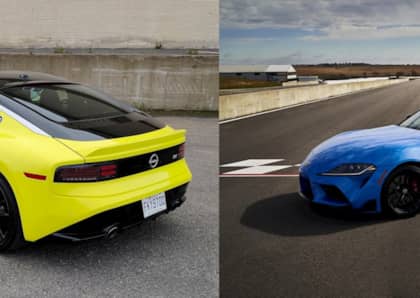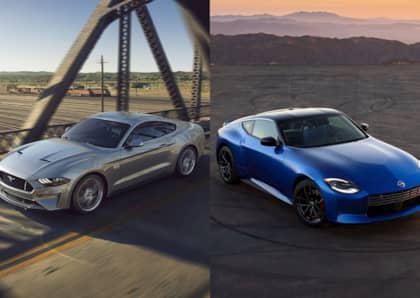Test Drive Review: 2023 Nissan Z Revives Its Glorious Turbocharged Sports Car Past
In some ways it's surprising it didn't happen earlier: the redesigned 2023 Nissan Z has lost the numeric appellation found with the previous-generation car and in the process gained a respectably mighty turbocharged power plant. Not only does this link the automaker's long-running sports car with its glorious twin-turbo past, but it also catches it up to the rest of the sports car pack—in particular the progress of its revived spiritual rival, the Toyota Supra.

Not everything is new with Nissan Z, but the key elements of its transformation are enough to put it back in the performance car conversation after having been surpassed by similarly-affordable fare over the past several years. I spent a week behind the wheel of the Z to determine how effectively its makeover covers past shortcomings, and find out whether the beefier coupe's personality has progressed or regressed in the fun-to-drive department.
Make Mine Turbo
The 2023 Nissan Z's 3.0L, twin-turbocharged V6 is a familiar one for fans of the brand, many of whom pined for it to be installed under the hood of the automaker's iconic two-seater almost as soon as it appeared in the Infiniti Q60 Red Sport for the 2017 model year. Featuring 400 hp and 350 lb-ft of torque (with the latter coming on at a low 1,600 rpm), it's a solid upgrade over even the mightiest version of the naturally-aspirated VQ V6 that came before it (which topped out at 350 ponies in NISMO trim and delivered 332 in all other models).

Five years is a puzzlingly long time to wait for an upgrade like this one, especially considering that at that point the 370Z had been on the market for nearly a decade without a major mechanical mojo boost. Chalk it up to internal inertia at Nissan, which was plagued with financial turbulence in the twenty-teens and had little spare cash lying around to splash on a slow-selling sports car.

Even today, the Nissan Z's redux is rife with budget-friendly decision-making. In addition to the borrowed power plant, the 370Z's basic platform has been retained, treated to a stiffening process and a suspension re-tune but otherwise a match for that found under the departing model. The interior, too, focuses on functionality rather than dazzling with its design, with a trio of traditional gauges (including, for some reason, turbo rpm rather than something more useful like oil pressure) joined by an attractive full LCD gauge cluster as the cabin's highlights. Leg room and headroom are a dead ringer for the 370Z it replaces, and cargo space remains modest and shallow under the rear hatch.

Externally, however, the 2023 Z makes the most of its familiar bones by draping them in an intriguing mix of old school styling cues, drawing from the original 240Z at the front and the Z32 300ZX at the rear. Blending design elements from disparate decades shouldn't work but here it does, especially when sprayed with eye-searing Ikazuchi Yellow paint as found on my tester. The car constantly grabbed attention whether driving or parked, which is an impressive feat for a model that starts at a very affordable $40,000.
More Power, More Fun
Putting it all together out on the road reveals how much the ghost of the 370Z lingers over the 2023 model. The rear end squats or steps out, depending on how much right pedal is applied on corner exit, with the car remaining eminently controllable through the entire range of its performance envelope. Despite its wide stance, the Z closes its cabin around you tighter and tighter as the corners increase their g-load on its 19-inch rubber. Colder fall weather made the Z a little more willing to slide than normal, especially with traction control switched off to its upright and locked position, but my Performance trim car's limited-slip differential and larger brakes (matched with slightly more aggressive aero) kept things entirely predictable.

Dip into the car's twin-turbos and you'll quickly Egon Spengler away any specters of the Z's recent past. The additional torque on tap from the 3.0L engine elevates the 2023 model's driving experience well above its predecessor, allowing you to take full advantage of what its willing chassis has to offer when changing direction. When found with its six-speed manual gearbox (which includes a terrifying no-lift shift feature), the Z now exhibits a liveliness that had seemingly flat-lined as the old VQ engine played out the string.

It's a combination that has it beating the more insulated Supra grand tourer and heavier-feeling Mustang GT in terms of overall experience. The Z's closest rival in terms of drive? The Alpha-platform Camaro SS, a vehicle that similarly transcends its modest roots to challenge sports cars costing significantly more money.
Big Bang For The Buck
The Z's price tag goes a long way towards alleviating issues like its elevated road noise, lack of rear seat, and average-at-best feature set, as well its surprisingly muted exhaust note (especially when compared against the V8 competition). At the entry-level, Nissan's coupe $40k is cheaper than the much weaker 4-cylinder edition of the Supra, with Toyota requiring a $52,000 investment to step up to twin-turbo six power. Even that is a few thousand dollars more than the Performance trim I drove, giving the Z a clear ponies-to-the-dollar advantage at every step of the ladder.

Nissan's coupe is also the closest thing to a pure sports car available for that kind of money, deftly pirouetting past Detroit's base V8 options in the handling department while overpowering the smaller, lighter and cheaper Toyota GR86/Subaru BRZ twins in a straight line. If the drive is what matters most—and if your personal tastes are attuned to the Nissan's throwback body work—then the Z should be on your sports car short list.











